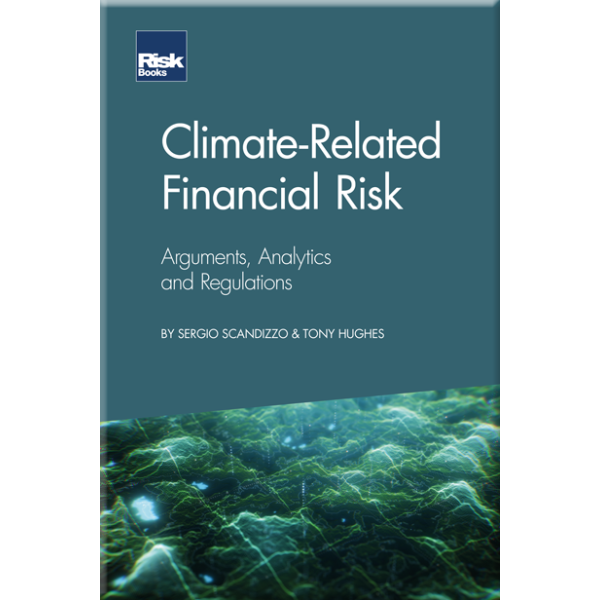Climate-Related Financial Risk - Arguments, Analytics and Regulations
In the face of an ever-evolving climate landscape, Climate-Related Financial Risk - Arguments, Analytics and Regulations provides a critical resource for financial professionals aiming to understand and mitigate the profound implications of climate change on the financial industry.
Esteemed authors Sergio Scandizzo and Tony Hughes take readers on a comprehensive journey which delves into the multifaceted aspects of climate-related financial risk. They offer a thorough analysis of current climate scenario and stress testing methodologies, of regulatory expectations and essential tools for effective risk management.
Their book provides guidance on what to look for in scenario-based stress test reports, enhancing financial practitioners’ ability to critically assess such documents. Each type of financial risk—credit, market, liquidity, and operational—is thoroughly examined in the context of climate change, with practical guidance on modelling and mitigation strategies.
In the face of an ever-evolving climate landscape, Climate-Related Financial Risk - Arguments, Analytics and Regulations provides a critical resource for financial professionals aiming to understand and mitigate the profound implications of climate change on the financial industry.
Esteemed authors Sergio Scandizzo and Tony Hughes take readers on a comprehensive journey which delves into the multifaceted aspects of climate-related financial risk. They offer a thorough analysis of current climate scenario and stress testing methodologies, of regulatory expectations and essential tools for effective risk management.
Their book provides guidance on what to look for in scenario-based stress test reports, enhancing financial practitioners’ ability to critically assess such documents. Each type of financial risk—credit, market, liquidity, and operational—is thoroughly examined in the context of climate change, with practical guidance on modelling and mitigation strategies.
Additionally, the authors consider the motivations and mandates of regulators and discuss current and future regulatory landscapes. They offer strategic recommendations for aligning financial institutions with evolving regulatory expectations and for building resilient financial systems.
Climate-Related Financial Risk - Arguments, Analytics and Regulations is indispensable for diverse financial professionals - including risk managers, analysts, regulators, and policymakers - who require the necessary knowledge and tools to safeguard their institutions against multifaceted climate change risks. This book is also highly relevant for academics and students specializing in finance, environmental economics, and sustainable development, providing them with a robust framework to understand the intersection of climate change and financial risk.
In an era where the financial sector faces mounting pressure to effectively incorporate climate risk management into decision-making processes, this book is timely, and an essential addition to the climate finance literature.
| ISBN | 9781782724483 |
|---|---|
| Navision code | MCRMZ |
| Publication date | 30/01/2025 |
Sergio Scandizzo and Tony Hughes
Sergio Scandizzo is Head of the Internal Modelling Division at the European Investment Bank in Luxembourg. He is also a distinguished writer, having authored a number of books – Risk and Governance, The Operational Risk Manager’s Guide and Validation and Use Test in AMA, all published by Risk Books, and The Validation of Risk Models, published by Palgrave Macmillan, as well as numerous journal articles and conference papers. Sergio is adjunct professor at the University of Luxembourg and an expert for Agence de Transfert de Technologie Financière (ATTF). Additionally, he is Associate Editor of The Journal of Operational Risk and the author of several journal papers on fuzzy logic, genetic algorithms and risk management. In 2009 he was recognised as one of the “Top 50 Faces of Operational Risk” by OpRisk and Compliance magazine. Sergio has extensive banking and risk management experience. Prior to his position at the EIB, he was a principal consultant in the London office of PricewaterhouseCoopers and, prior to that, a senior manager in the Global Risk Advisory team at the Canadian Imperial Bank of Commerce in Toronto. He holds advanced degrees in computer science and finance. Tony Hughes is a prolific commentator and occasional industry consultant with expertise in credit risk modelling, financial climate risk and macroeconomics. He has been a columnist for the Global Association of Risk Professionals (GARP) since 2018 and, in 2023, co-founded the UnpackingClimateRisk.com newsletter that focuses on methodological and regulatory issues related to the treatment of financial climate-related risk. He has contributed several chapters to Risk.Net books on climate risk and credit modelling more broadly and has published countless research white papers, op-eds and academic papers in a wide range of industry-focused journals. His career has taken him from his native Australia, first to the United States, where he was Managing Director and Head of Consumer Credit for Moody’s Analytics, and then to the UK in 2017. In this role, he developed a number of innovative modelling approaches and worked directly with major banking organisations. In Australia he first worked as an academic at Monash, UNSW and the University of Adelaide, conducting research and teaching courses in theoretical and applied econometrics. He moved to industry in the early 2000s as the Chief Asia Pacific Economist for Economy.com, covering Australia, China and Japan, while also taking broad responsibility for coverage of the entire region. He was awarded a PhD in econometric theory from Monash University in Melbourne in 1997.
| PART 1: TAKING THE LONG VIEW: CLIMATE, SCENARIOS AND STRESS TESTING | |
| 1 | Regulator motivation and aims |
| 2 | Scenarios |
| 3 | Two underappreciated climate risk topics: Exposure at default and asset valuation |
| 4 | Assessing the available evidence related to consumer credit risk |
| PART 2: FEELING THE HEAT: CLIMATE-RELATED FINANCIAL RISK | |
| 5 | The modelling of climate-related financial risk |
| 6 | Credit risk – Probabilities of default models |
| 7 | Climate-related loss given default |
| 8 | Market risk |
| 9 | Liquidity risk |
| 10 | Operational risk |
| 11 | The (limited) power of disclosures |
| PART 3: THE REGULATORY VIEW: A MODEST PROPOSAL | |
| 12 | Financial regulators’ climate mandate should be formalised |
| 13 | Where to for climate risk regulation? |
| 14 | Conclusions: Using finance to drive climate solutions |




